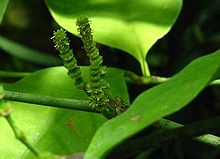| Gnetophyta Temporal range:
| |
|---|---|

| |
| Gnetum luofuense with female cones | |

| |
| Welwitschia mirabilis female plant with cones | |
| Scientific classification | |
| Kingdom: | Plantae |
| Clade: | Tracheophytes |
| Clade: | Gymnospermae |
| Division: | Gnetophyta Bessey 1907 |
| Class: | Gnetopsida Thom 1886 |
| Families and genera | |
|
Gnetaceae | |

| |
| Distribution, separated by genus: Green – Welwitschia Blue – Gnetum Red – Ephedra Purple – Gnetum and Ephedra | |
Gnetophyta (/nɛˈtɒfɪtə, ˈnɛtoʊfaɪtə/) is a division of plants (alternatively considered the subclass Gnetidae or order Gnetales), grouped within the gymnosperms (which also includes conifers, cycads, and ginkgos), that consists of some 70 species across the three relict genera: Gnetum (family Gnetaceae), Welwitschia (family Welwitschiaceae), and Ephedra (family Ephedraceae). The earliest unambiguous records of the group date to the Jurassic, and they achieved their highest diversity during the Early Cretaceous. The primary difference between gnetophytes and other gymnosperms is the presence of vessel elements, a system of small tubes (xylem) that transport water within the plant, similar to those found in flowering plants. Because of this, gnetophytes were once thought to be the closest gymnosperm relatives to flowering plants, but more recent molecular studies have brought this hypothesis into question, with many recent phylogenies finding them to be nested within the conifers.
Though it is clear they are all related, the exact evolutionary inter-relationships between gnetophytes are unclear. Some classifications hold that all three genera should be placed in a single order (Gnetales), while other classifications say they should be distributed among three separate orders, each containing a single family and genus. Most morphological and molecular studies confirm that the genera Gnetum and Welwitschia diverged from each other more recently than they did from Ephedra.[1][2][3][4][5]






- ^ Peter R. Crane; Patrick Herendeen; Else Marie Friis (2004). "Fossils and plant phylogeny". American Journal of Botany. 91 (10): 1683–1699. doi:10.3732/ajb.91.10.1683. PMID 21652317.
- ^ Cite error: The named reference
Bowewas invoked but never defined (see the help page). - ^ Gugerli, F.; Sperisen, C.; Buchler, U.; Brunner, L.; Brodbeck, S.; Palmer, J.D.; Qiu, Y.L. (2001). "The evolutionary split of Pinaceae from other conifers: evidence from an intron loss and a multigene phylogeny". Molecular Phylogenetics and Evolution. 21 (2): 167–175. doi:10.1006/mpev.2001.1004. PMID 11697913.
- ^ Rai, H.S.; Reeves, P.A.; Peakall, R.; Olmstead, R.G.; Graham, S.W. (2008). "Inference of higher-order conifer relationships from a multi-locus plastid data set". Botany. 86 (7): 658–669. doi:10.1139/B08-062.
- ^ Ickert-Bond, S. M.; C. Rydin & S. S. Renner (2009). "A fossil-calibrated relaxed clock for Ephedra indicates an Oligocene age for the divergence of Asian and New World clades, and Miocene dispersal into South America" (PDF). Journal of Systematics and Evolution. 47 (5): 444–456. doi:10.1111/j.1759-6831.2009.00053.x. S2CID 55148071.